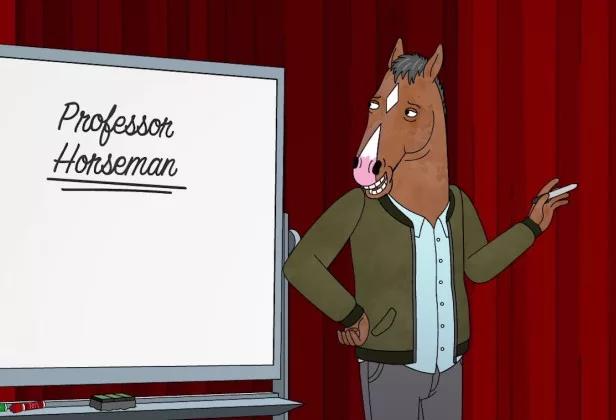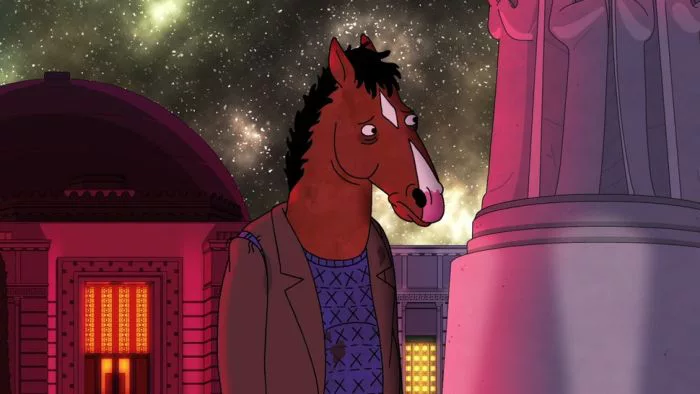If a few years ago someone told me that the talking horse would be the face of the dialogue about mental health, the façade of show business and the meanders of human existence, I would probably scream with pity. And yet! Raphael Bob-Waksberg (together with a group of devilishly talented scriptwriters and animators), against all expectations, created an outstanding series. Unfortunately, all that is good has to come to an end one day.
Everyone can see what a horse is like
This time we meet BoJack where Diane left him recently – at the gates of the luxurious “Pastiches” addiction therapy center. Realizing his problem (as well as the huge impact it has had on his surroundings for years), the star finally decides to ask for help. He will be accompanied by a smuggled bottle of vodka – this time, however, not so much in the form of an illegal gadget brought to rehab only because celebrities are allowed a bit more than mere mortals, but a kind of talisman reminding about the tragic implications of decisions made in the past.
And although the horse itself does well and seems (in great pain) to go straight, it is not a lonely island. Slowly, like a massive snowball, the specter of consequences approaches him; for perhaps the first time in his life, BoJack will be forced to take responsibility for his actions – especially since a pair of journalists are trampling his hooves, quite rightly linking him to the tragic death of Sarah Lynn.

Source: tvline.com
The horse has four legs and will stumble too
You can feel the omnipresent decline this season. Famous and liked heroes set new paths and priorities for themselves. Certain accounts diminish slowly, almost imperceptibly. Similarly, the story itself dies out – this time devoid of spectacular plot solutions and shocking twists. The most important things are ordinary human (animal?) Relationships – with others, and above all with oneself. The leitmotif is change; the anthropomorphic bunch is forced to leave the zone of sitcom comfort and face the issues that have been pushed so far (more or less consciously) to the fringes of consciousness. Even the most hardened Mr. Peanutbutter lets in his problem – pathological dependence on other partners – and finally takes a step forward.
Somewhere in this cauldron is also BoJack, for which others, however, find less and less space in their surroundings. The horse tries his best and for a moment it even seems that he has managed to find his headland away from the hustle and bustle and toxic lights of Hollywood. But he, too, finally realizes that he does not live in a vacuum, and that the past cannot simply be cut off – no matter how thick the line is. Thanks to this, we will see many familiar faces – like the ghosts of past holidays, all those who had an impact on his life (or vice versa ) return to BoJack , which reaches its climax in the wonderfully surreal episode entitled The View From Halfway Down .
However, it is impossible to deny the impression that some threads move much too quickly, while others – previously signaled as important – are lost between the lines. It is an extremely crowded season, and it is impossible to blame only the creators for it (the decision to end the series was not made by them, but sinister “suits” from Netflix). Despite this density, the writers managed to get out of the situation unscathed – the final series of episodes by BoJack Horseman , though bittersweet, satisfactorily closes the story. At the same time, it is a surprisingly subdued and muted ending.

Source: bustle.com
Lach without a horse like a body without a soul
The technical side of BoJack does not disappoint either . The animators (under the watchful eye of Lisa Hanawalt and Mike Hollingsworth) have managed to prove how much they are aware of forms and make full use of the practically unlimited possibilities of this medium. Different styles of animation intertwine with each other, illustrating the complex narratives and internal states of the characters. Also actors lending voices to characters – incl. Will Arnett, Aaron Paul, Alison Brie, Amy Sedaris and Paul F. Tompkins – they don’t rest on their laurels even on the final straight. Thanks to them, two-dimensional talking animals never cease to seem painfully human, with all the baggage that “our” existence carries with it.
I approach this final with mixed feelings. Not because he is bad – quite the opposite. However, I feel like saying goodbye to a good friend, and such break-ups never come easy. But what to do – to paraphrase Diane, things don’t always go our way, but life goes on.

